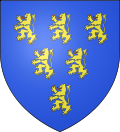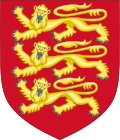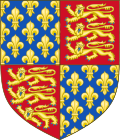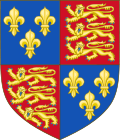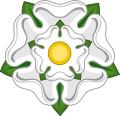- Margaret of Anjou
-
Margaret of Anjou 
Margaret of Anjou receiving the Book of Romances. From an illuminated manuscript by the Talbot Master Queen consort of England (first time) Tenure 23 April 1445 – 4 March 1461 Coronation 30 May 1445 Queen consort of England (second time) Tenure 30 October 1470 – 11 April 1471 Spouse Henry VI of England Issue Edward of Westminster, Prince of Wales House House of Valois (by birth)
House of Lancaster (by marriage)Father René, King of Naples Mother Isabella, Duchess of Lorraine Born 23 March 1430
Pont-à-Mousson, LorraineDied 25 August 1482 (aged 52)
Anjou, FranceBurial Angers Cathedral, Anjou Margaret of Anjou (French: Marguerite d'Anjou) (23 March 1430[1][2] – 25 August 1482) was the wife of King Henry VI of England. As such, she was Queen consort of England from 1445 to 1461 and again from 1470 to 1471; and Queen consort of France from 1445 to 1453.[3] Born in the Duchy of Lorraine, into the House of Valois-Anjou, Margaret was the second eldest daughter of René I of Naples and Isabella, Duchess of Lorraine.
She was one of the principal figures in the series of dynastic civil wars known as the Wars of the Roses, having led the Lancastrian faction. Due to Henry's frequent bouts of insanity, Margaret ruled the kingdom in her husband's place. It was she who, in May 1455, called for a Great Council which excluded the Yorkist faction headed by Richard, Duke of York, and thus provided the spark which ignited the civil conflict that lasted for over thirty years, decimated the old nobility, and caused the deaths of thousands of men, including her only son Edward of Westminster, Prince of Wales at the Battle of Tewkesbury.
Margaret was taken prisoner by the victorious Yorkists after the Lancastrian defeat at Tewkesbury in May 1471; in 1475, she was ransomed by her cousin, Louis XI of France. She went to live in France as a poor relation of the French king, and died there at the age of 52.
Contents
Early life and marriage
 Margaret of Anjou's arms as Queen consort of England[4]
Margaret of Anjou's arms as Queen consort of England[4]
Margaret was born on 23 March 1430, in Pont-à-Mousson in the Duchy of Lorraine, an Imperial fief east of France that was ruled by the cadet branch of the French kings, the House of Valois-Anjou. Margaret was the second eldest daughter of René I of Naples, Duke of Anjou and Bar, King of Naples and Sicily and Isabella, Duchess of Lorraine.
On 23 April 1445, Margaret married King Henry VI of England, who was eight years her senior, at Titchfield in Hampshire. Henry at the time also claimed the Kingdom of France and controlled various parts of northern France. Margaret's uncle, Charles VII, who also claimed the crown of France, agreed to the marriage of his niece to his rival on the condition that he would not have to provide the customary dowry and instead would receive the lands of Maine and Anjou from the English.
Margaret was fifteen years old, and described as beautiful and "already a woman: passionate and proud and strong-willed",[5] and knew her duty which was to fervently protect the interests of the Crown.[6] She inherited this indomitability from her mother who fought to establish her husband's claim to the Kingdom of Naples, and her paternal grandmother Yolande of Aragon, who actually governed Anjou "with a man's hand", putting the province in order and keeping out the English.[7] Thus by family example and her own forceful personality, she was fully capable of becoming the "champion of the Crown".[8]
Birth of a son
Henry, who was more interested in religion and learning than military matters, was not a successful king. He had reigned since he was only a few months old and his actions had been controlled by regents. When he married Margaret, his mental condition was already unstable and by the time their only son, Edward of Westminster, was born on 13 October 1453, he had suffered a complete breakdown. Rumours were rife that he was incapable of fathering a child and that the new Prince of Wales was the result of an adulterous liaison. Many have speculated that either Edmund Beaufort, 2nd Duke of Somerset or James Butler, Earl of Wiltshire, both staunch allies of Margaret, were the young prince's actual father. However, it is important to note that the political factions against her were intent on spreading the rumours to discredit Edward's claim to the throne; it is possible that Henry was the father of Edward.
Although Margaret was aggressively partisan, feudal and had a volatile temperament,[5] by dint of her cultured upbringing, she shared her husband's love of learning and gave her patronage to the founding of Queens' College at Cambridge University. Elizabeth Woodville, future Queen of England, allegedly served as her Maid of Honour.
Beginnings of the dynastic civil wars
Enmity between Margaret and the Duke of York
After retiring from London to live in lavish state at Greenwich, Margaret was occupied with the care of her young son and did not display any signs of overt belligerence until she believed her husband was threatened with deposition by the ambitious Richard Plantagenet, 3rd Duke of York[9] who, to her consternation, had been appointed regent while Henry was mentally incapacitated from 1453 to 1454. The duke was a credible claimant to the English throne and by the end of his regency there were many powerful nobles and relatives prepared to back his claim. There are perhaps few episodes in English history that give so much room for speculation and debate, however, as the origins and the proper place of blame, if any, in the Wars of the Roses. The Duke of York was powerful; Henry's advisors corrupt; Henry himself trusting, pliable, and increasingly unstable; Margaret defiantly unpopular, grimly and gallantly determined to maintain the English crown for her progeny. Yet at least one scholar identifies the source of the eventual Lancastrian downfall not as York's ambitions nearly so much as Margaret's ill-judging enmity toward York and her over-indulgence in unpopular allies.[10] Nevertheless, Queen Margaret was a powerful force in the world of politics. King Henry was putty in her hands when she wanted something done.[11]
Margaret's biographer, Helen Maurer, however, disagrees with earlier historians having dated the much-vaunted enmity between the Queen and York to the time he obtained the office of the regency. She suggests the mutual antagonism came about two years later in 1455 in the wake of the First Battle of St. Albans when she perceived him as a challenge to the King's authority. She bases this on a judicious study of Margaret's pattern of presenting gifts; this revealed that Margaret took a great deal of care to demonstrate that she favoured both York and Somerset equally in the early 1450s. Maurer also claims that Margaret appeared to accept York's regency and asserts there is no substantial evidence to back up the long-standing belief that she was responsible for the Yorkists' exclusion from the Great Council following Henry's recovery. (see below)[12]
Late academic and historian Paul Murray Kendall, on the other hand, maintained that Margaret's allies, Somerset and William de la Pole, then Earl of Suffolk, had no difficulty in persuading her that York, until then one of Henry VI's most trusted advisors, was responsible for her unpopularity and already too powerful to be trusted. Margaret not only convinced Henry to recall York from his post as governor in France and banish him instead to Ireland, she repeatedly attempted to have him assassinated during his travels to and from Ireland, once in 1449 and again in 1450.[13] Somerset's and Suffolk's joint responsibility for the secret surrender of Maine in 1448, and then the subsequent disastrous loss of the rest of Normandy in 1449 embroiled Margaret and Henry's court in riots, and uprisings by the magnates, and calls for the impeachment and execution of Margaret's two strongest allies to that point. It also may have made an ultimate battle to the death between Margaret and the House of York inevitable, by making manifest Richard's dangerous popularity with the Commons. Richard of York, safely returned from Ireland in 1450, confronted Henry and was readmitted as a trusted advisor. Soon thereafter, Henry agreed to convene Parliament to address the calls for reform. When Parliament met, the demands could not have been less acceptable to Margaret: not only were both Somerset and Suffolk impeached for criminal mismanagement of French affairs and subverting justice, but it was charged as a crime against Suffolk (now a duke) that he had antagonised the King against the Duke of York. Further, the demands for reform put forward included that the Duke of York be acknowledged as the first councillor to the king, and the Speaker of Commons, perhaps with more fervour than wisdom, even proposed Richard, Duke of York, be recognised as heir to the throne.[14] Within a few months, however, Margaret had regained control of Henry, Parliament was dissolved, the incautious Speaker thrown in prison for his troubles, and Richard of York retired to Wales for the time being.[15]
In 1457, the kingdom was again outraged, when it was discovered that Pierre de Brézé, a powerful French general and an adherent of Margaret, had landed on the English coast and burnt the town of Sandwich, as leader of a French force of 4,000 men from Honfleur, aimed at taking advantage of the chaos in England. The mayor, John Drury, was killed in this raid. It thereafter became an established tradition, which survives to this day, that the Mayor of Sandwich wears a black robe mourning this ignoble deed. Margaret, in association with de Brézé, became the object of scurrilous rumours and vulgar ballads. Public indignation was so high that Margaret, with great reluctance, was forced to give the Duke of York's kinsman Richard Neville, 16th Earl of Warwick a commission to keep the sea for three years. He already held the post of Captain of Calais.[16]
Leader of Lancastrian faction
Hostilities between the rival Yorkist and Lancastrian factions soon flared into armed conflict. In May 1455, just over five months after Henry VI recovered from a bout of mental illness and Richard of York's regency had ended, Margaret called for a Great Council from which the Yorkists were excluded. The Council called for an assemblage of the peers at Leicester to protect the king "against his enemies." York apparently was prepared for conflict and soon was marching south to meet the Lancastrian army marching north. The Lancastrians suffered a crushing defeat at the First Battle of St Albans on 22 May 1455. Somerset was killed, Wiltshire fled the battlefield and King Henry was taken prisoner by the victorious Duke of York.
Although the king was captured, Margaret managed to escape and immediately began raising an army in Wales and the north of England, where she was assisted by Henry's half-brother, Jasper Tudor. In 1459, hostilities resumed at the Battle of Blore Heath, where Margaret is said to have witnessed her commander, James Touchet, Lord Audley, defeated by a Yorkist army under Richard Neville, 5th Earl of Salisbury.[by whom?]
The Wars of the Roses
Military campaigns
While she was attempting to raise further support for the Lancastrian cause in Scotland,[17] her principal commander, Henry Beaufort, 3rd Duke of Somerset,[18] gained a major victory for her at the Battle of Wakefield on 30 December 1460, by defeating the combined armies of Richard Plantagenet, Duke of York, and the Earl of Salisbury. Both men were beheaded and their heads displayed on the gates of the city of York. As Margaret was in Scotland at the time the battle had taken place, it was impossible that she issued the orders for their executions despite popular belief to the contrary.[19] She followed up with a victory at the Second Battle of St Albans (at which she was present) on 17 February 1461, where she defeated the Yorkist forces of Richard Neville, 16th Earl of Warwick, and recaptured her husband. It was after this battle that she, in a blatant act of vengeance, ordered the execution of two Yorkist prisoners-of-war, William Bonville, 1st Baron Bonville and Sir Thomas Kyriel, who had kept watch over King Henry to keep him out of harm's way during the battle. The King had promised the two knights immunity, but Margaret gainsaid him and ordered their executions by decapitation. It is alleged that she put the men on trial at which presided her son. "Fair son", she allegedly asked, "what death shall these knights die?", Prince Edward replied that their heads should be cut off, despite the King's pleas for mercy.[20]
The Lancastrian army was beaten at the Battle of Towton on 29 March 1461 by the son of the late Duke of York, Edward IV of England, who deposed King Henry and proclaimed himself king. Margaret was determined to win back her son's inheritance, and fled with him into Wales and later Scotland. Finding her way to France, she made an ally of her cousin, King Louis XI of France, and at his instigation she allowed an approach from Edward's former supporter, Richard Neville, Earl of Warwick, who had fallen out with his former friend, as a result of Edward's marriage to Elizabeth Woodville and was now seeking revenge for the loss of his political influence. Warwick's daughter, Anne Neville, was married to Margaret's son, Edward, Prince of Wales, in order to cement the alliance, and Margaret insisted that Warwick return to England to prove himself, before she followed. He did so, restoring Henry VI briefly to the throne on 3 October 1470.
Defeat at Tewkesbury
By the time Margaret, her son and daughter-in-law were ready to follow Warwick back to England, the tables had again turned in favour of the Yorkists, and the Earl had been defeated and killed by the returning King Edward IV in the Battle of Barnet on 14 April 1471. Margaret was forced to lead her own army at the Battle of Tewkesbury on 4 May 1471, at which they were defeated and her seventeen-year old son was killed. The circumstances of Edward's death have never been made clear; and it is not known whether he was killed in the actual fighting or executed after the battle by the Duke of Clarence. He was the only Prince of Wales to die in battle. Over the previous ten years, Margaret had gained a reputation for aggression and ruthlessness, but following her defeat at Tewkesbury and the death of her only son, she was completely broken in spirit. After she was taken captive by William Stanley at the end of the battle, Margaret was imprisoned by the order of King Edward. She was sent first to Wallingford Castle and then was transferred to the more secure Tower of London; in 1472 she was placed in the custody of her former lady-in-waiting Alice Chaucer, Duchess of Suffolk, where she remained until ransomed by Louis XI in 1475.[21]
Death
She lived in France for the next seven years as a poor relation of the king. She died on 25 August 1482, at the age of fifty-two, in Anjou. She was entombed next to her parents in the cathedral of Angers. Her remains were removed and scattered by revolutionaries who ransacked the cathedral during the French Revolution of 1789.
Margaret's letters
There are many letters extant written by Margaret during her tenure as queen consort. One was written to the Corporation of London regarding injuries done to her tenants at the manor of Enfield, which comprised part of her dower lands.[22] There is another letter which she wrote to the Archbishop of Canterbury.[23][24] The letters are compiled in a book edited by Cecil Monro, which was published for the Camden Society in 1863.[25] Margaret typically headed her letters with the words "By the Quene".[26]
Ancestors
Ancestors of Margaret of Anjou 16. John II of France 8. Louis I, Duke of Anjou 17. Bonne of Bohemia 4. Louis II of Naples 18. Charles, Duke of Brittany 9. Marie of Blois 19. Joan, Duchess of Brittany 2. René of Anjou 20. Peter IV of Aragon 10. John I of Aragon 21. Eleanor of Sicily 5. Yolande of Aragon 22. Robert I, Duke of Bar 11. Violant of Bar 23. Marie of France 1. Margaret of Anjou 24. Rudolph, Duke of Lorraine 12. John I, Duke of Lorraine 25. Marie of Blois-Châtillon 6. Charles II, Duke of Lorraine 26. Eberhard II, Count of Württemberg 13. Sophie of Württemberg 27. Elizabeth von Henneberg-Schleusingen 3. Isabella, Duchess of Lorraine 28. Rupert II, Elector Palatine 14. Rupert of Germany 29. Beatrice of Sicily 7. Margaret of the Palatinate 30. Frederick V, Burgrave of Nuremberg 15. Elisabeth of Nuremberg 31. Elisabeth of Meissen Depictions in fiction
Margaret is a major character in William Shakespeare's three-part play Henry VI, Part 1, Part 2 and Part 3. She also appears as an old woman in Richard III. Margaret is the title character of Giacomo Meyerbeer's 1820 opera Margherita d'Anjou.
She is also the subject of Betty King's 1974 biographical novel Margaret of Anjou, Alan Savage's 1994 novel Queen of Lions, Anne Powers' historical romance The Royal Consorts, and Susan Higginbotham's 2011 novel The Queen of Last Hopes. Sharon Kay Penman's novel The Sunne in Splendour features her as an important character in the early parts of the book, up until the Battle of Tewkesbury. Jean Plaidy's The Red Rose of Anjou also features her.
She also is the subject of a fictional biography, "The Royal Tigress" by a fictional character, David Powlett-Jones who is the main subject of R.F.Delderfield's novel of a Welsh schoolmaster at a Devon public school from The 1st world war to the battle of Britain in the 40s. Delderfield, in the person of Powlett-Jones, appears to have a very good grasp of Margaret's life and the wars of the roses and the content and development of the book give us an entertaining sub-plot to the books' main narrative.
References
- ^ Encyclopedia Britannica
- ^ The Complete Peerage, V, p.213
- ^ Hookham, Mary Ann, The life and times of Margaret of Anjou, queen of England and France, 1872.
- ^ Boutell, Charles (1863), A Manual of Heraldry, Historical and Popular, London: Winsor & Newton, pp. 276
- ^ a b Kendall, p.19
- ^ Kendal, p.19
- ^ Kendall, Paul M., Richard The Third, p.19.
- ^ ib. Kendall, p. 19.
- ^ ib. Kendall, pp. 30–31.
- ^ ib. Kendall, pp. 18, 19, 24: "Excessive greed and ambition—the besetting sins of his contemporary peers—seem to have been largely absent from his character. It would require the unrelenting enmity of a queen to remind him that he owned a better title to the throne than Henry the Sixth," id. at 18. "It appears that Richard, Duke of York, was neither aiming at the crown nor seeking more of a voice in the government than he was entitled to. He represented, to many Englishmen of the day, the only hope of rescue from the swamp of disorder and evil rule in which the realm was floundering." Id. at p. 517n8.
- ^ Fraser, Antonia, The Lives of the Kings and Queens of England, p. 139.
- ^ Review of Maurer, Helen (2003). Margaret of Anjou: Queenship and Power in Late Medieval England. Retrieved 1 March 2011
- ^ ib. Kendall, pp. 21–23, citing The Paston Letters, vol. 4, as original source.
- ^ ib. Kendall, pp. 21–23.
- ^ ib. Kendall, pp. 13–14. When York and the king and queen met again, on a field of truce at Blackheath in 1452, he found himself ambushed and taken prisoner while Somerset was again restored to honours. Id.
- ^ ib. Kendall, p. 32.
- ^ Haigh, Philip A., The Military Campaigns of the Wars of the Roses Stroud, Alan Sutton Publishing Ltd, 1995, p. 32. ISBN 978-0938289906.
- ^ Wagner, J.A., Encyclopedia of the Wars of the Roses, Santa Barbara: ABC-CLIO Inc., 2001, p. 26. ISBN 1851093583.
- ^ Kendall, p..39 – 40
- ^ Thomas B. Costain, The Last Plantagenets, p.305, published by Popular Library, New York, 1962
- ^ Maurer
- ^ Letters of Queen Margaret of Anjou and Bishop Beckington and Others, edited by Cecil Monro, Esq., published for the Camden Society, M.DCCC.LXIII, pp.98–98, Google Books, retrieved on 24-02-10
- ^ Monro, p.99-100
- ^ As the letter was not dated, the Archbishop to whom she wrote has not been ascertained; according to Cecil Munro, it was most likely either John Stafford, who held the office from 13 May 1443 to 25 May 1452 or Cardinal John Kempe, who held it from 21 July 1452 to 22 March 1454
- ^ Letters of Queen Margaret of Anjou and Bishop Beckington, and Others, edited by Cecil Monro, Esq., published for the Camden Society, M.DCCC.LXIII, Google Books, retrieved on 24-02-10
- ^ Monro, pp.89–165
- . Kendall, Paul Murray "Richard the Third", George Allen & Unwin Ltd., London, 1955, ISBN 0 04 942048 8
Further reading
- Maurer, Helen E. Margaret of Anjou: Queenship and Power in Late Medieval England. Boydell Press, 2003.
- Abott, Jacob. History of Margaret of Anjou, Queen of Henry VI of England. Reproduction of 1871 text by Kessinger Press, 2004.
- Bagley, J.J. Margaret of Anjou, Queen of England. Herbert Jenkins, London, 1948.
Margaret of AnjouCadet branch of the Capetian dynastyBorn: 23 March 1430 Died: 25 August 1482English royalty Vacant Title last held byCatherine of ValoisQueen consort of England
Lady of Ireland
23 April 1445 – 4 March 1461Succeeded by
Elizabeth WoodvillePreceded by
Elizabeth WoodvilleQueen consort of England
Lady of Ireland
30 October 1470 – 11 April 1471English Royal Consorts Matilda of Flanders (1066–1083) · Matilda of Scotland (1100–1118) · Adeliza of Louvain (1121–1135) · Matilda I of Boulogne (1135–1152) · (Geoffrey V of Anjou?) (1141) · Eleanor of Aquitaine (1154–1189) · Margaret of France (1172–1183) · Berengaria of Navarre (1191–1199) · Isabella of Angoulême (1200–1216) · Eleanor of Provence (1236–1272) · Eleanor of Castile (1272–1290) · Margaret of France (1299–1307) · Isabella of France (1308–1327) · Philippa of Hainault (1328–1369) · Anne of Bohemia (1383–1394) · Isabella of Valois (1396–1399) · Joanna of Navarre (1403–1413) · Catherine of Valois (1420–1422) · Margaret of Anjou (1445–1471) · Elizabeth Woodville (1464–1483) · Anne Neville (1483–1485) · Elizabeth of York (1486–1503) · Catherine of Aragon (1509–1533) · Anne Boleyn (1533–1536) · Jane Seymour (1536–1537) · Anne of Cleves (1540) · Catherine Howard (1540–1542) · Catherine Parr (1543–1547) · (Lord Guilford Dudley?) (1553) · Anne of Denmark (1603–1619) · Henrietta Maria of France (1625–1649) · Catherine of Braganza (1662–1685) · Mary of Modena (1685–1688) · George of Denmark (1702–1707)Wars of the Roses Red Rose of Lancaster · White Rose of York · Tudor Rose Key figures Margaret of Anjou, Queen of England · Henry Percy, 2nd Earl of Northumberland · Henry Percy, 3rd Earl of Northumberland · Richard Neville, 16th Earl of Warwick · Edmund Beaufort, 2nd Duke of Somerset · Henry Beaufort, 3rd Duke of Somerset · Edmund Beaufort, 4th Duke of Somerset · George Plantagenet, 1st Duke of ClarenceBattles Lancastrian victoriesYorkist victoriesFirst Battle of St Albans · Battle of Blore Heath · Battle of Sandwich · Battle of Northampton · Battle of Mortimer's Cross · Battle of Ferrybridge (Indecisive) · Battle of Towton · Battle of Hedgeley Moor · Battle of Hexham · Battle of Lose-coat Field · Battle of Barnet · Battle of TewkesburySee also  Book:Wars of the Roses ·
Book:Wars of the Roses ·  Category:Wars of the Roses ·
Category:Wars of the Roses ·  Portal:England / MonarchyCategories:
Portal:England / MonarchyCategories:- English royal consorts
- 1430 births
- 1482 deaths
- Irish royal consorts
- Founders of English schools and colleges
- House of Valois-Anjou
- Ladies of the Garter
- People of the Wars of the Roses
- Women of medieval England
- Women of medieval France
- Women in Medieval warfare
- Female regents
- 15th-century female rulers
- 15th-century French people
- 15th-century English people
- 15th-century women
- Prisoners in the Tower of London
- Henry VI of England
Wikimedia Foundation. 2010.




